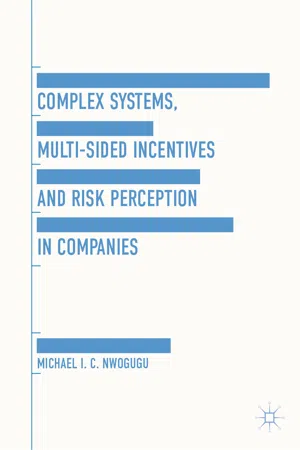
Complex Systems, Multi-Sided Incentives and Risk Perception in Companies
- English
- ePUB (mobile friendly)
- Available on iOS & Android
Complex Systems, Multi-Sided Incentives and Risk Perception in Companies
About This Book
Most research about financial stability and sustainable growth focuses on the financial sector and macroeconomics and neglects the real sector, microeconomics and psychology issues. Real-sector and financial-sectors linkages are increasing and are a foundation of economic/social/environmental/urban sustainability, given financial crises, noise, internet, "transition economics", disintermediation, demographics and inequality around the world. Within complex systems theory framework, this book analyses some multi-sided mechanisms and risk-perception that can have symbiotic relationships with financial stability, systemic risk and/or sustainable growth. Within the context of Regret Minimization, MN-Transferable Utility and WTAL, new theories-of-the-firm are developed that consider sustainable growth, price stability, globalization, financial stability and birth-to-death evolutions of firms. This book introduces new behaviour theories pertaining to real estate and intangibles, which can affect the evolutions of risk-taking and risk perception within organizations and investment entities. The chapters address elements of the dilemma of often divergent risk perceptions of, and risk-taking by corporate executives, regulators and investment managers.
Frequently asked questions
Information
1. Introduction
Table of contents
- Cover
- Front Matter
- 1. Introduction
- 2. Belief-Revision, Algorithms and Equity-Based Incentives Under Combined MN-TU, Regret-Minimization and Perception Regimes
- 3. Group Decision-Making and Belief-Systems in REITs and “RECs”: Theories of Financial Stability, Antitrust, Games and Complex Systems
- 4. Perception-Based Decisions, Strategic Alliances and Optimal Financial Contracting: Auctions, Strategic Alliances and a Critique of Third-Generation Prospect Theory and Related Approaches
- 5. Intangibles Accounting Regulations and the “Global Intangibles Economy”: Belief-Revision, Enforcement Theory and Financial Stability
- 6. Knowledge-Representation, Belief Systems and an Index of the Seller’s Propensity-To-Sell Real Estate
- 7. Knowledge-Representation and Network Decisions in Franchising and Online-Retailing Under Combined MN-Transferable-Utility, WTAL, Perception and Regret-Minimization Regimes
- 8. On Franchise Royalty Rates, Franchise Fees and Incentive Effects
- 9. Some Knowledge-Representation, Group-Decision and Risk-Perception Implications of Board-Governance Models and the Corporations-Model
- 10. Reasoning, Knowledge Representation and Algorithmic Turning-Point Problems Given Anomalies Inherent in DERs and ASRs
- 11. Reasoning and Repeated Decisions in Financial Distress
- 12. Complex Systems and International Political Economy: The Externalities/Governmental-Influence Theory of the Firm
- 13. Complex Systems, International Political Economy and the Behavioral/Contracts Theory of the Firm
- 14. Complex Systems, International Political Economy and the Communications/Information-Differential Theory of the Firm
- 15. Complexity and Some Numerical Algorithmic Turning-Point Problems Inherent in Excessive Outstanding Shares
- 16. Conclusion
- Back Matter